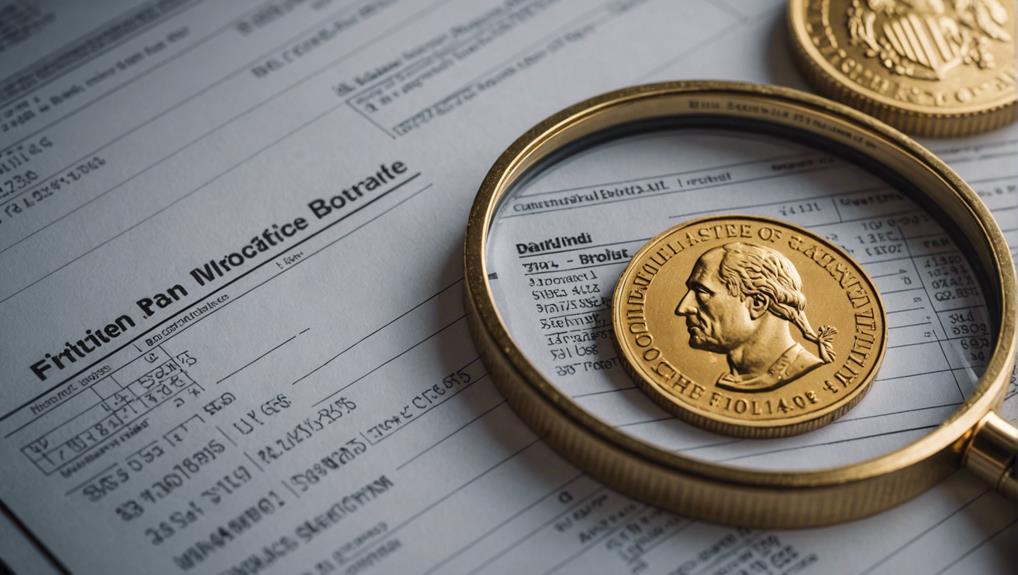Practical Guide to Diversifying Your 401(K) With Gold
To diversify your 401(k), consider the strategic inclusion of gold in your investment portfolio. Allocating a portion of your retirement savings to gold mutual funds, ETFs, or a Gold IRA can enhance your portfolio's resilience against inflation and market volatility. Gold's unique performance, often independent of traditional assets, provides a hedge during periods of economic instability and geopolitical events.
It's crucial to understand IRS regulations and secure storage solutions to ensure compliance and safety. How can you embark on this path to a more diversified retirement plan?
My Quick Highlights
- Invest in gold mutual funds or ETFs to gain indirect exposure to gold by holding shares in gold mining companies.
- Allocate a portion of your 401(k) to gold to hedge against inflation and minimize overall portfolio risk.
- Roll over your 401(k) to a Gold IRA for tax advantages and protection against market volatility.
- Ensure gold investments meet specific fineness standards and are managed by an IRS-authorized custodian to ensure compliance.
- Utilize physical gold options like bars, coins, and bullion or diversify with gold ETFs and mutual funds for enhanced resilience.
401(k) Investment Options

When expanding your 401(k), consider gold mutual funds and ETFs for indirect exposure to gold. These funds invest in companies involved in gold mining and production, offering a way to include gold in your asset allocation without owning physical gold.
Gold mutual funds pool money from many investors to buy a variety of gold mining stocks, which can reduce risk. Gold ETFs, or exchange-traded funds, are similar but trade like stocks on an exchange, making them more flexible.
Adding these gold-related funds to your 401(k) helps broaden your portfolio, potentially balancing risk and reward. By including gold mutual funds and ETFs, you can access gold's potential benefits while maintaining a diversified investment strategy.
Benefits of Gold
Gold offers numerous benefits, acting as a hedge against inflation and market volatility while preserving wealth and purchasing power. Investing in a Gold IRA provides physical ownership of precious metals, serving as a tangible asset in a retirement portfolio. This diversification balances the risks associated with traditional investments like stocks and bonds.
Including gold can safeguard savings from economic uncertainty. Its historical performance as an inflation hedge ensures purchasing power remains intact, even during unstable market conditions.
| Benefit | Description |
|---|---|
| Inflation Hedge | Protects purchasing power during inflationary periods. |
| Market Stability | Offers stability in your portfolio during economic fluctuations. |
| Tangible Asset | Provides physical ownership through a Gold IRA, enhancing portfolio security. |
Diversification Strategies

Allocating a portion of your 401(k) to gold is a strategic way to diversify and minimize overall portfolio risk. Gold often moves independently of stocks and bonds, making it a valuable addition to your investment mix.
This independence helps protect against market volatility and provides a hedge during economic uncertainty. Including gold in your 401(k) enhances your portfolio's resilience, reducing the impact of inflation and economic fluctuations. This can potentially improve long-term performance.
Balancing your investments with gold prepares you to handle unpredictable market conditions, ensuring a more stable financial future.
Rolling Over to Gold IRA
Transferring your 401(k) to a Gold IRA can offer you significant benefits, including tax-deferred growth and protection against market volatility.
You'll need to follow specific steps to complete the rollover process, such as selecting a reputable custodian and ensuring proper transfer of funds.
Benefits of Gold IRA
Switching to a Gold IRA can help protect your retirement savings from inflation and market instability. By rolling over to a Gold IRA, you gain an inflation hedge, safeguarding your wealth during economic uncertainty.
Gold IRAs offer tax advantages, allowing your investments to grow tax-deferred, which can significantly benefit your retirement savings. Historically, gold has preserved wealth better than many other assets during times of market volatility.
Moving your retirement funds into a Gold IRA ensures that your savings are protected from inflationary pressures, providing a stable foundation for your future. It's important to understand the tax implications and work with reputable professionals to manage this beneficial transition effectively.
Rollover Process Steps
To begin the rollover process, select a reputable Gold IRA company such as Goldco or Augusta Precious Metals.
Establishing a self-directed IRA account is the next step, allowing you to manage your investments.
Opt for a direct rollover method to avoid taxes and penalties when moving funds from a 401(k) to a Gold IRA.
Here's a simple checklist to assist you:
- Explore and Choose: Research the Gold IRA company's reputation, fees, and services.
- Set Up Your Account: Establish a self-directed IRA with the chosen company.
- Transfer Funds: Use the direct rollover method to ensure compliance with IRS regulations.
Work closely with your Gold IRA company to facilitate a smooth transition.
IRS Rules for Gold IRAs

Understanding IRS rules for Gold IRAs is crucial for expanding your retirement portfolio with precious metals. A Gold IRA allows investment in gold, provided the investments meet specific fineness standards to qualify for tax benefits.
Direct investment in physical gold through a traditional 401(k) isn't permitted, necessitating a Gold IRA for this purpose. A custodian must manage the account to ensure compliance with IRS regulations.
Including precious metals like gold in your retirement planning can offer diversification benefits, enhancing portfolio resilience. Adhering to these IRS guidelines ensures your investments are compliant and advantageous for your financial future.
Types of Gold for IRAs
When evaluating types of gold for your IRA, you'll come across options like physical gold, Gold ETFs, and gold mutual funds. Physical gold includes IRS-approved bars and coins, while Gold ETFs and mutual funds offer more flexibility and ease of trading.
Each option has its benefits, thus understanding their differences can help you make an informed choice.
Physical Gold Options
Investors can diversify their 401(K)s by including physical gold options such as bars, coins, and bullion that meet IRS standards. This diversification with physical gold provides stability and security.
Here are three types of gold that qualify:
- Gold Bars: Available in various weights (1 oz, 10 oz, 1 kilogram), these bars meet IRS fineness standards, offering flexible investment options.
- Gold Coins: IRA-approved coins like the American Eagle, Canadian Maple Leaf, and South African Krugerrand are popular choices due to their reliability and purity.
- Gold Bullion: Typically 99.5% pure, bullion is a common choice for those investing in physical gold.
Gold ETFs Benefits
Gold ETFs provide a straightforward way to diversify your 401(K) or IRA with the benefits of gold, eliminating the hassle of physical storage. These exchange-traded funds offer direct exposure to gold prices, enabling efficient diversification of your retirement accounts. Popular options include GLD (SPDR Gold Shares) and IAU (iShares Gold Trust).
Liquidity is another major advantage of gold ETFs, as they can be easily bought and sold on stock exchanges. This liquidity ensures your investments remain flexible and accessible.
Additionally, gold ETFs enhance diversification by spreading investment risk across different assets. Incorporating gold ETFs into your retirement accounts allows you to benefit from gold's stability without the challenges of managing physical gold.
Gold Mutual Funds
Consider diversifying your 401(k) with gold mutual funds, which invest in companies involved in gold mining, production, or distribution. These funds provide an indirect way to gain exposure to the gold industry, thereby enhancing your retirement portfolio's diversification. While you don't need to own physical gold, you can still benefit from the potential capital appreciation of gold-related companies.
To get started, you have several options:
- Actively managed funds: Managed by professionals aiming to outperform the market by selecting specific gold-related stocks.
- Passively managed funds: These funds track a gold-related index, offering lower fees and requiring less active management.
- Global gold funds: Investing in gold companies worldwide, these funds provide international diversification.
Including gold mutual funds in your 401(k) can add both stability and growth potential to your retirement savings.
Potential Risks

When diversifying your 401(k) with gold, it's crucial to recognize the potential risks involved. Gold investments can be volatile, with prices fluctuating based on market conditions.
Diversifying with gold helps mitigate risks linked to traditional investments, but gold itself carries its own set of risks. Economic instability and changes in interest rates can significantly impact gold's value. Additionally, geopolitical events and currency fluctuations strongly influence gold prices.
Before including gold mutual funds or ETFs in your 401(k), carefully assess these risks and consider their impact on your overall investment strategy. This understanding is vital for effectively managing your 401(k).
Storage and Custody
To secure your gold investments, use custodians and storage facilities authorized by the IRS. Storing gold in an IRS-approved depository ensures compliance and safety. These facilities adhere to strict regulations to protect your assets, with custodians managing them to provide security and peace of mind.
When setting up your gold IRA, consider:
- Trustee-to-Trustee Transfer: This method facilitates a seamless transfer of funds without incurring tax penalties.
- Approved Custodians: Select IRS-authorized custodians to manage your gold IRA.
- Secure Storage: Utilize an IRS-approved depository to properly safeguard your precious metals.
Conclusion
Diversifying your 401(k) with gold can be a valuable strategy to strengthen your retirement portfolio. By incorporating gold through mutual funds, ETFs, or a Gold IRA, you gain a hedge against inflation and market volatility.
Follow IRS rules and choose authorized custodians for compliance and security. While gold adds resilience, it's vital to weigh potential risks and ensure proper storage. This strategy can help you achieve a more balanced and secure retirement plan.
The Gold Information Network
11900 Biscayne Blvd, Ste 127B, Miami, FL 33181
(305) 449-9094
https://goldinfo.net
source https://rondewitt.com/diversifying-401k-gold/
Comments
Post a Comment